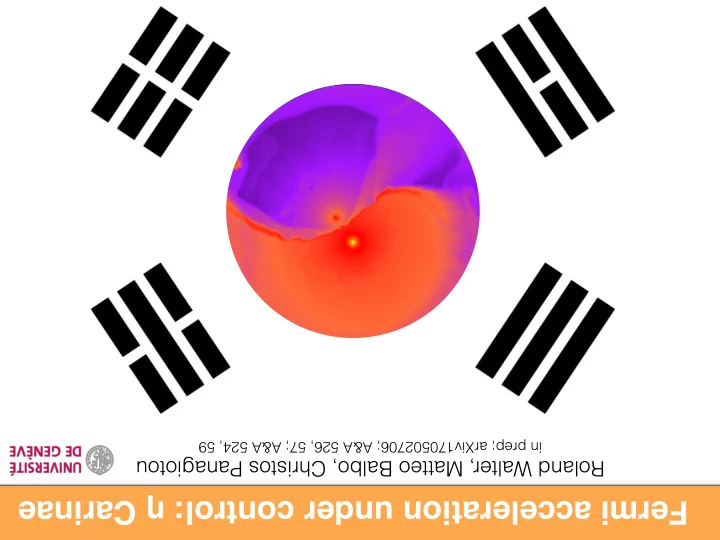

in prep; arXiv170502706; A&A 526, 57; A&A 524, 59 Roland Walter, Matteo Balbo, Christos Panagiotou Fermi acceleration under control: η Carinae
Who is η Car ? M ∼ 10 � 3 . 5 M � / yr ˙ L wind ≈ 2000 L �
Who is η Car ? M ∼ 10 � 3 . 5 M � / yr ˙ L wind ≈ 2000 L �
Orbital variability X-rays INTEGRAL FERMI 0.3 - 10 GeV L π 0 ≈ 10 L ⊙
3D hydro simulations (Thermal simulations from Parkin et al, 2011) B (G) 400 electrons electrons Parkin et al, 2011 e - spectrum smooth IC spectrum gamma gamma
3D hydro simulations (Thermal simulations from Parkin et al, 2011) B (G) 400 photons photons Parkin et al, 2011 e - spectrum smooth IC spectrum
η Car γ -ray light-curves i.e. electrons 0.3 - 10 GeV L(therm)~n 2 L(IC)~n 10 - 300 GeV i.e. hadrons L( π 0 )~n 2
η Car γ -ray light-curves 0.3 - 10 GeV
Hadronic spectrum Periastron Averaged Apastron knee of the CR spectrum
What happened during last periastron ? Corcoran (2015) Possible interpretation Larger wind clumpiness or dM/dt x 10 ➙ Stronger thermal emission (~ n 2 ) x 5.5 3-10 GeV ➙ lower Υ max,p
Energetics Thermal X-rays: 25 L ⊙ Synchrotron: < 0.1 L ⊙ Electron acceleration: 50 L ⊙ π 0 emission: 10 L ⊙ neutrino: ~ 10 -9 GeV s -1 cm -2 (above 10 TeV) η Carinae shows evidences for electronic and hadronic acceleration Electron spectral index is compatible with 2.25 Proton cutoff energy ≳ 1013 eV, higher than measured in middle aged SNR Efficiency of particle acceleration ~ 1% (Spitkovsky’s simulations: 10%) With this efficiency, a massive star could accelerate ~ 10 49 ergs of cosmic-rays, as much as an average SNR. M17 (Omega nebula) Chandra (0.5-2/2-8 keV) L X =1 L ⊙ 10% of OB stellar wind luminosity (Townsley et al., 2005)
Lepto-hadronic or hadronic ? CTA will probe γ - γ absorption, wind e-Astrogam structure and high energy cuto ff will tell Variability expected at periastron ) y 1 ( m a Ohm et al, 2015 g o r t s A - e CTA (50hrs)
Conclusions 1. Low energy lightcurve (0.3-10 GeV) • Modulation is driven by the orbital motion. • Flux varied by 50% in less than 40 days ➔ smaller than the homonculus • Variability matches simulations for B surf ∼ 400G ➔ IC emission likely • X-ray and gamma-ray minima consistent ➔ disappearance of CWZ 2. The high energy lightcurve (>10GeV) is poorly constrained • Pion disintegration matches amplitude of variability • Inverse Compton emission is ruled out at such energies • Periastron are different ➔ clumpy wind ? • Eta Carinae may accelerate as much hadrons as a SNR 3. Some consensus for hadronic acceleration 4. Prominent source for CTA and e-Astrogam 5. A CWB could accelerate as much cosmic-rays as an average SNR
Recommend
More recommend